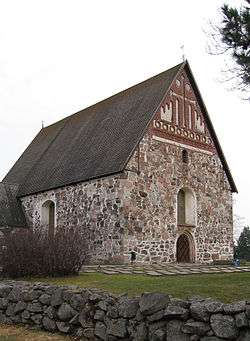Sipoo
| Sipoo Sipoo – Sibbo | ||
|---|---|---|
| Municipality | ||
|
Sipoon kunta Sibbo kommun | ||
 Sipoo Old Church | ||
| ||
 Location of Sipoo in Finland | ||
| Coordinates: 60°22.5′N 025°16′E / 60.3750°N 25.267°ECoordinates: 60°22.5′N 025°16′E / 60.3750°N 25.267°E | ||
| Country |
| |
| Region | Uusimaa | |
| Sub-region | Greater Helsinki | |
| Charter | 1425 | |
| Seat | Nikkilä | |
| Government | ||
| • Chairman of the municipal board | Eero Seppänen | |
| • Chairman of the municipal assembly | Christel Liljeström | |
| • Municipal manager | Mikael Grannas | |
| Area (2018-01-01)[1] | ||
| • Total | 698.60 km2 (269.73 sq mi) | |
| • Land | 339.62 km2 (131.13 sq mi) | |
| • Water | 358.97 km2 (138.60 sq mi) | |
| Area rank | 225th largest in Finland | |
| Population (2018-08-31)[2] | ||
| • Total | 20,491 | |
| • Rank | 59th largest in Finland | |
| • Density | 60.34/km2 (156.3/sq mi) | |
| Population by native language[3] | ||
| • Finnish | 59.5% (official) | |
| • Swedish | 38.6% (official) | |
| • Others | 1.9% | |
| Population by age[4] | ||
| • 0 to 14 | 21.7% | |
| • 15 to 64 | 64.7% | |
| • 65 or older | 13.6% | |
| Time zone | UTC+2 (EET) | |
| • Summer (DST) | UTC+3 (EEST) | |
| Municipal tax rate[5] | 19.25% | |
| Climate | Dfb | |
| Website | www.sipoo.fi | |
Sipoo (Finnish pronunciation: [ˈsipoː]; Swedish: Sibbo) is a municipality of Finland. Its seat is in Nikkilä (Nickby).
Geography
It is the eastern neighbour of Helsinki and is located in the Uusimaa region. The municipality has a population of 20,491 (31 August 2018)[2] and covers an area of 698.60 square kilometres (269.73 sq mi) of which 358.97 km2 (138.60 sq mi) is water.[1] The population density is 60.34 inhabitants per square kilometre (156.3/sq mi).
The once almost completely Swedish-speaking municipality is bilingual since 1953, a majority being Finnish speakers, due to migration from other parts of Finland since 2003. Today the Finnish-speaking majority stands at 60% and the Swedish-speaking minority is about 39% of the population.[3]
On June 26, 2006, the Sipoo town council decided on a strategy to triple the municipality's population over the next 25 years. The decision was made after Helsinki announced plans to annex a part of the municipality in order to continue to build high-end urbanizations in the coastline (and thus high-tax revenue producing). The Finnish Council of State voted in favor of the annexation on June 28, 2007, with votes 8 to 4.[6] Sipoo appealed to the Supreme Administrative Court, but the court upheld the decision of the Council of State[7] and the annexation took place on January 1, 2009. As Helsinki did not directly border Sipoo at any point, the city of Vantaa ceded the area lain between Helsinki and Sipoo to Helsinki in the process.
Twin towns
See also
References
- 1 2 "Area of Finnish Municipalities 1.1.2018" (PDF). National Land Survey of Finland. Retrieved 30 January 2018.
- 1 2 "Ennakkoväkiluku kuukausittain sukupuolen mukaan alueittain, elokuu 2018" (in Finnish). Statistics Finland. Retrieved 21 October 2018.
- 1 2 "Population according to language and the number of foreigners and land area km2 by area as of 31 December 2008". Statistics Finland's PX-Web databases. Statistics Finland. Retrieved 29 March 2009.
- ↑ "Population according to age and gender by area as of 31 December 2008". Statistics Finland's PX-Web databases. Statistics Finland. Retrieved 28 April 2009.
- ↑ "List of municipal and parish tax rates in 2011". Tax Administration of Finland. 29 November 2010. Retrieved 13 March 2011.
- ↑ "Hallitus hyväksyi Sipoo-liitoksen". YLE Uutiset (in Finnish). Helsinki: Yleisradio Oy. 2007-06-28. Archived from the original on 14 May 2011. Retrieved 25 January 2009.
- ↑ Supreme Administrative Court Precedent KHO:2008:1, ruled on January 15, 2008 (in Finnish)
External links
![]()
- Municipality of Sipoo – Official website
- Pictures
- Map of Sipoo

